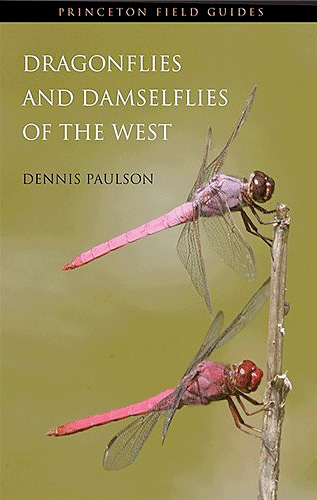
Dragonflies and Damselflies of the West
Dennis Paulson
Princeton University Press
Paperback
535 pages
2009
Living in British Columbia, I’m fortunate to have a copy of Rob Cannings Introducing the Dragonflies of British Columbia and Yukon as a field guide when I’m out photographing dragonflies or practicing a little catch and release. It’s a handy, light field guide (94 pages) that covers BC dragonflies very well.
That being said, I was very excited when I found out that Dennis Paulson had put together a field guide for western North American dragonflies. I’d used his Field Key to Adult Washington Dragonflies in the past and his gallery of photographs of Washington State odonata is an exceptional resource.
Dragonflies and Damselflies of the West is a comprehensive field guide that covers 348 species of odonata found in western North America. It is an excellent book for anyone who is interested in learning how to identify dragonflies and damselflies.
Paulson’s writing is very readable and the book includes a detailed section on the natural history of these insects, as well as anatomical descriptions and diagrams that are very useful for learning identification features. In addition, information is provided on how to find dragonflies, how to identify them, how to photograph them, and how to collect them. Also in this section is an overview of what is included in the species accounts and how to use them.
The main part of the book focuses on the species accounts. Like other odonata field guides, Dragonflies and Damselflies of the West is organized into two main sections – Damselflies (Zygoptera) and Dragonflies (Anisoptera). Within each of these sections, there is a short general description of each family followed by a general description of the genus and then finally the individual species accounts.
I liked the detail provided in the species accounts. Each species is described thoroughly and an identification section provides helpful field marks to look for as well as the names of other dragonflies or damselflies that look similar in appearance. This is followed by a natural history section with good information about behaviour that can be useful in establishing an identification. Habitat, flight season, and distribution are also described. Finally, each account includes a range map and photographs of both male and female insects. Unfortunately, if you’re new to dragonflies you’ve got a lot of book to search through to find the dragonfly you’re interested in and there isn’t a key to get you started. Unless you’ve got it in the hand, it may be a challenge to figure out what it is using this field guide.
Paulson also provides line drawings of anatomical features that are crucial for positive identification of similar looking species. For example, Pond Spreadwings (Lestes) have two full pages devoted to drawings of male and female appendages.
Each large genus has a table to aid in identification that compares each species based on several different features. This table works like a simple key but I personally found it a little confusing. One has to jump back and forth between the list of species and the four or more features (each of which is further broken down into 2 or more different features). I guess it saves space, but a more typical key would have made more sense in my opinion, and I think that most users will find it frustrating. I’d much rather use Canning’s visual diagram of the Mosaic Darners (retained from the original The Dragonflies of British Columbia BCPM Handbook #35 – if you can find a copy and you live in BC, buy it!) to sort out the darners. Canning’s table uses drawings of the side stripes and the “T Spot” that makes it easy to quickly figure out which is which.
For the odonata enthusiast, I think that it is in the field that Paulson’s book will fall short. For one, it’s just too heavy to pack and to big to use when you’re thigh deep in water with a net in one hand and a camera in the other. A better alternative for field use in British Columbia would be Canning’s Introducing the Dragonflies (light, great photos, excellent keys). Beginners in the United States would probably prefer to use Dragonflies through Binoculars by Sidney W. Dunkle. While it doesn’t have the line drawings that Paulson’s and Canning’s books do, it is considerably lighter than Dragonflies and Damselflies of the West and since all of the images, range maps, and a short description are grouped in the center of the book (more detailed accounts are referenced), probably a little easier to use.
All in all, Paulson’s book is better suited for a situation when you’ve got time to sit down and examine your dragonfly or damselfly in detail. There is a wealth of information in the species accounts that make it an excellent reference book and a great addition to the naturalist’s library. If you’ve narrowed your identification down to a couple of species in the field, Dragonflies and Damselflies of the West should help you to sort it out.